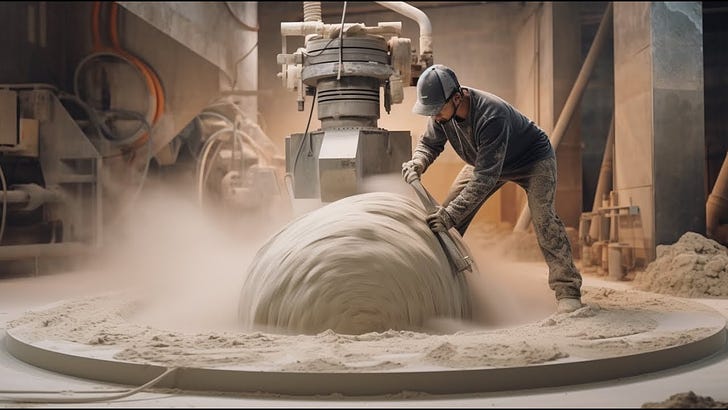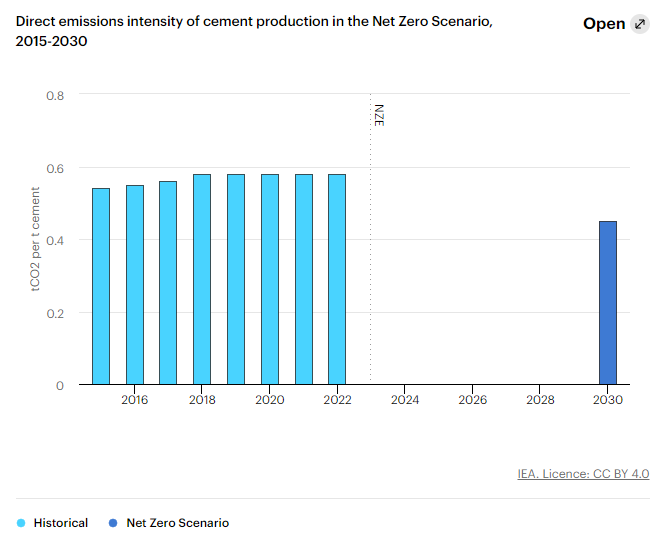Cement is a killer material.
It’s literally holding together our civilization.
But it’s also killing our climate:
Cement production is responsible for about 7% of our total global CO2 emissions.
That’s more than aviation, shipping, and landfills combined.
How can we crack this challenge?
Let’s find out.
What is cement?
Cement is a binding agent used in construction to hold materials together. It’s a crucial component in concrete, which, in turn, is a composite material made from cement, aggregates such as sand and gravel, water, and sometimes additives.
It’s literally everywhere: Human consumption of concrete is second only to water!
How do we produce cement today?
Today's cement production relies mainly on limestone, sand, and clay, which are fired in kilns at temperatures around 1,500 degree Celsius. Complex chemical reactions occur before cement is formed, which is then mixed with water, sand, and gravel to create concrete.
Here’s a great video explaining the process in more detail:
What’s the issue with cement production?
The actual culprit is clinker, the primary component of cement. Its production is very energy-intensive - and means double-trouble for the climate:
Problem 1: You need inferno-like heat. To create it, we have to burn a lot of fossil fuel.
Problem 2: The chemistry stuff: During clinker production, heat liberates limestone (a process called calcination) into calcium oxide and … CO2.
About 40% of CO2 emissions from cement stem from the combustion of fossil fuels for heat generation. The chemical reactions contribute roughly 60% of the emissions.
If the global cement industry was a country, it would be the third-largest CO2 emitter, after China and the US. And fabricating one ton of cement results in about 900 kg of CO2 emissions.
The real question is:
How to decarbonize the cement industry while meeting the growing demands of global infrastructure development?
What are the alternatives?
Before we check out some fascinatic green cement developments, we have to acknowledge that the industry has been improving its efficiency for decades. For example, the industry’s specific energy consumption in the EU has dropped by 30% since the 1970s.
The main pathways to reduce cement’s devastating climate impact:
improving energy efficiency of kilns and processes
replacing fossile fuels with alternative fuels (like industrial residues or biomass)
developing alternative raw materials
producing multi-constituent cement (for example, clinker + slag or fly ash)
reducing the clinker ratio in cement
decarbonizing electricity and transport
deploy CCUS (Carbon Capture Utilization and Storage)
Fly ash and slag are considered transition solutions. Their supply will shrink as decarbonization efforts evolve in steel production and waste management.
Here’s a selection of companies that are working on more sustainable concrete solutions (we are not affiliated to any of them!):
Sublime: replaces the energy-intensive heating process with electricity
Brimstone: uses silicates instead of limestone
CarbonBuilt: Repurposes mining waste to replace cement in concrete
C-Crete Technologies: utilizes locally available minerals and industrial by-products while absorbing CO2 from the atmosphere over time
CarbonCure: injects carbon dioxide into concrete, where it undergoes a mineralization process, becoming embedded in the concrete
Seratech: developes a technology to sequester carbon, which in lab settings, can already produce zero-carbon concrete
EcoMaterial Technologies: avoids carbon emissions related to cement manufacturing, restoring the planet's carbon cycle balance
VTT Decarbonate: conducts experiments for an electrically heated rotary kiln, aiming to reduce emissions in cement production
Cambridge Electric Cement: offers an emissions-free route to recycle Portland cement, significantly reducing energy consumption and overall emissions
Material Evolution: replaces limestone with a chemical solution, creating a cement-like product through fusion reactions, without requiring heat
Carbonaide: pioneers carbon-negative concrete production using industrial side streams and CO2 capture, utilization and storage technologies
BioZeroc: develops bio-based concrete using biotech and existing materials, eliminating the need for cement in the manufacturing process.
CCB Greentech: enables the production of precast load-bearing walls and slabs made of wood-based concrete, trapping CO2 inside the wood for the cement's lifetime
CemVision: replaces virgin limestone with industrial byproducts like slag products from steel or mining industries
Carbon Upcycling: utilizes waste glass for cement production, contributing to circular economy practices.
Prometheus Materials: cultivates cyanobacteria in bioreactors, which photosynthesize CO2 into calcium carbonate. This bio-cement is mixed with aggregates to create concrete, offering a sustainable alternative to traditional cement production.
Carbon Re: leverages Digital Twins technology to optimize operations and improve efficiency, reducing emissions by up to 15%
Why is it so hard to find greener cement alternatives?
“You’re bloody hard to abate, mate.”
Cement is one of those hard problems:
It’s a “high stakes, low margin” industry. Large-scale plant construction is very expensive, making it hard for newcomers to enter the game.
In addition, quality is a major concern. Introducing new methods requires convincing customers of consistency and reliability.
According to the IEA, CCUS (Carbon Capture, Utilization and Storage) will have to deliver around 60% of the emission reductions required to achieve the 2050 Net Zero Goal. CCUS definitely deserves an article on its own. It’s complex, potentially promising, but also veeery controversial. So far, it has definitely not been able to live up to the hype. CCUS comes in various forms and they all share the same goal: To capture, reuse, and lock away the CO2 that is emitted during cement production.
The thing is: Retrofitting plants with CCUS technology is pretty expensive.
Not good, considering the main “market logic” challenge:
To produce green cement for the same price or cheaper than the current standard.
Between Greenwashing and real action
“Green Cement” already sounds like the Champions League of Greenwashing attempts, doesn’t it?
Some players in the industry have been trying to label their concrete “low-carbon”, even though it is based on standard compositions which have been in use for decades. The lines between conventional and “low-carbon” concrete are getting blurrier.
This mess has caused the Low Carbon Concrete Group to advocate for a more precise definition of low-carbon concrete. They propose a grading system, akin to energy efficiency ratings for appliances, where different strengths of concrete are assigned an embodied carbon rating from A++ to G.
Some studies suggest that the construction and manufacturing sectors must reduce their material usage by 40 to 60%.
Well, that’s gonna be tough, given that global cement production is forecasted to grow by 23% until the year 2050.
The Global Cement and Concrete Association's (GCCA) 2050 Cement and Concrete Industry Roadmap for Net Zero Concrete, along with tools like the Green Cement Technology Tracker show that the industry has begun to tackle the challenge.
Another example is the Decarbonized Cement and Concrete Alliance (DC2). Founded in January 2024, DC2 comprises alternative cement developers, sequestration companies, circular concrete producers, and developers of hydrothermal processing technology. Let’s see what they can do…
To be fair: Once it has been produced, concrete actually absorbs CO2 from the atmosphere throughout its lifetime. This process is called cement recarbonation, or just carbon uptake. This technically reduces emissions over its lifespan.
Conclusion: Will the transition become concrete?
There are four main challenges on the way to decarbonizing cement:
1: The burning of fossil fuels to create the necessary heat for the production of clinker
2: The chemical process of calcination releasing large amounts of CO2
3: the forecasted growth in demand for cement, particularly from developing markets like India
4: the highly localized nature of cement production, requiring compliance from a wide range of regional stakeholders
Beyond these challenges, the environmental impact of cement production extends to airborne pollution, including dust, gases, noise, and vibration, along with countryside damage resulting from quarrying activities.
Cement is a concrete climate problem.
The good news: There’s a lot of smart, creative, talented, and courageous people out there trying to fix it.
Cement is one of those “invisible yet everywhere” challenges. Not spectaculare, not cute, not shiny. And definitely not going to make the news like a polar bear floating on an iceberg.
But still crucial.
Time to turn the concrete jungle green.
TRANSITION TRACKER
Selected news, commentaries, and stories from around the world.
QUOTE OF THE WEEK
“Humanity’s ability to cope with climate change hinges on reducing emissions and adapting to extreme weather. Building energy codes can tackle both: they can decrease energy emissions while increasing people’s safety.”
Meredydd Evans, Earth Scientist, Pacific Northwest National Laboratory
Talk to you next week.
Lennard
PS: If you like this newsletter, please share it with others and spread the word. Thank you for your support!





